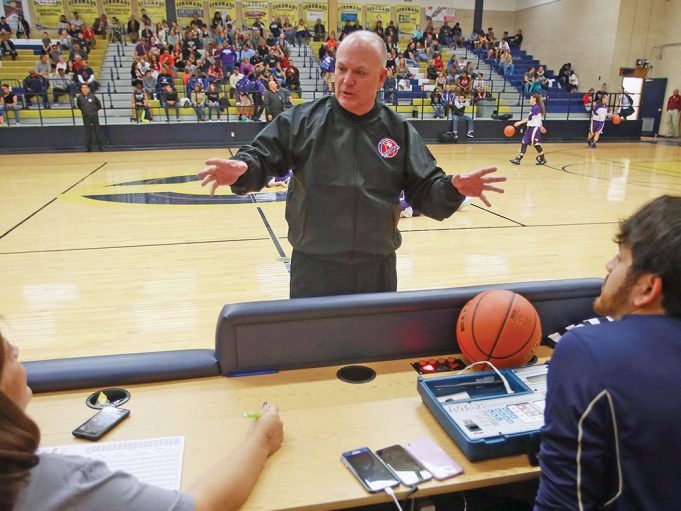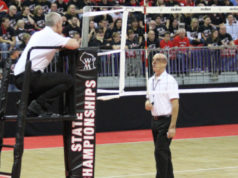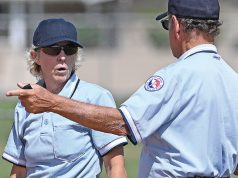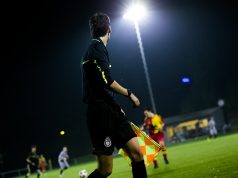At a time when scrutiny of officials is greater than ever before, the need to get plays right is Job One. Most evaluators won’t judge too harshly an official who may not be in the absolute best position according to the manual but still makes a correct ruling on the play. Unless the official freelances his or her positioning the entire game, judgment trumps mechanics almost every time.
With all of the pressure officials face while play is in progress, it’s easy to forget that what happens while play is stopped is just as important as what happens during active play. An official who views timeouts or the time between plays as dead time is asking for trouble.
Here are six things you need to do before play resumes after a stoppage.
1. Make eye contact with your partners.
Just because you’re ready to go, it doesn’t mean those you’re working with are in the same state of preparedness. They may be tying a shoe, addressing a clock or equipment problem, talking to a coach or player or just plain daydreaming. Restarting the game before everyone’s ready can result in having to redo the restart, which makes you look less than professional.
You should also make sure game-related auxiliary personnel (e.g. the chain crew, scorers, timers) are in place and ready to go as well.
2. Consider the game situation.
Understanding what strategy the teams may employ when play resumes helps you plot your positioning ahead of time. The score, juncture of the game and other factors should all be noted and analyzed. Knowing which rules may come into play when the action resumes will prevent you from being surprised when a situation arises.
Runners on first and third may be a precursor for a squeeze bunt or double steal. A football team emptying its backfield, putting the quarterback in shotgun position and stacking one side of the formation with eligible receivers might indicate a Hail Mary pass or “pick” play.
3. Check for obstacles or other potential dangers.
Cheerleaders or dance teams using props such as pompoms or run-through banners sometimes leave debris behind on the playing surface. Make a quick but thorough visual scan of the area to be sure it’s safe to proceed.
Fans anticipating the end of the game will sometimes move closer to the court or field. If necessary, get the help of game management to keep the crowd back so they don’t become entangled with athletes or officials and don’t interfere with play.
If the game was stopped because a player was bleeding, be sure that any affected areas are properly cleaned. If the rules of the sport cover situations in which players have blood on their uniforms, ensure that the uniform is either free of blood or changed.
Ensure that game apparatus (e.g. nets, pylons, goals) is in order.
Balls used for between-innings or between-halves warmups may have not been collected. Scan the field or court to ensure there are no strays that could present danger or confusion to the participants.
4. Count the players.
Don’t allow a team to put itself at a disadvantage by restarting play with fewer than the required number of players. By the same token, if the rules of the game allow you to help a team correct a situation in which it has too many or too few players, take advantage of the rule.
5. Know the clock status.
In sports that use a game clock, know if and when the game clock is supposed to start. That is especially important at the end of periods when time is precious.
6. Observe injured players.
If play was stopped because a player was injured, note if the player is attempting to return to the game. In some cases, the rules require that if play was stopped because of an injury, the player may not return to action immediately. If the injury is so severe that the rules require the player to receive written clearance from a physician before participating, you must obtain the document and keep it for your records.
Also, casually look over the players and their equipment. Are jerseys tucked in? Is all required equipment present and being worn properly? Preventive officiating before the play saves you from having to be the unpopular “uniform police” who assesses what many perceive to be a nitpicky penalty once play resumes.
What's Your Call? Leave a Comment:
Note: This article is archival in nature. Rules, interpretations, mechanics, philosophies and other information may or may not be correct for the current year.
This article is the copyright of ©Referee Enterprises, Inc., and may not be republished in whole or in part online, in print or in any capacity without expressed written permission from Referee. The article is made available for educational use by individuals.


















